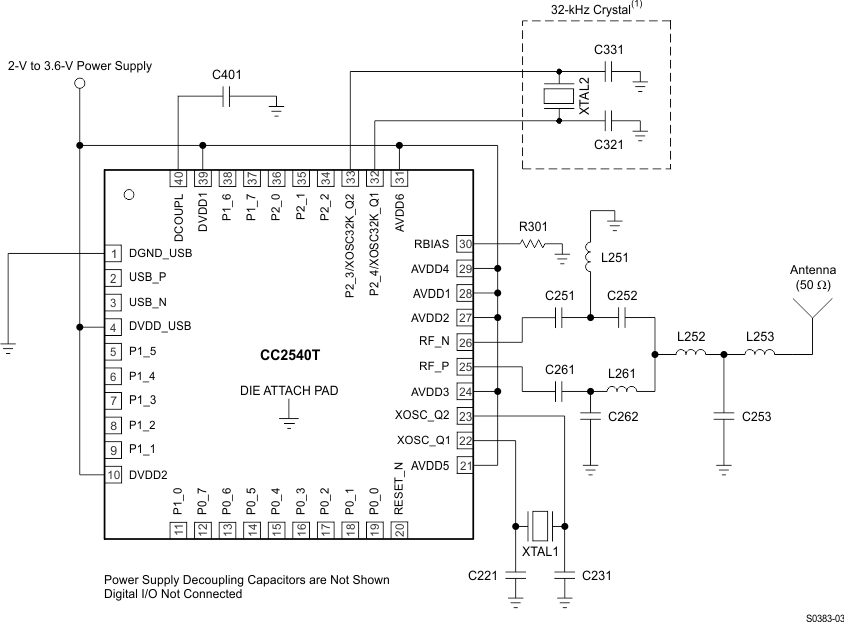SWRS172A July 2014 – November 2015 CC2540T
PRODUCTION DATA.
- 1Device Overview
- 2Revision History
- 3Terminal Configuration and Functions
-
4Specifications
- 4.1 Absolute Maximum Ratings
- 4.2 ESD Ratings
- 4.3 Recommended Operating Conditions
- 4.4 Electrical Characteristics
- 4.5 Thermal Resistance Characteristics for RHA Package
- 4.6 General Characteristics
- 4.7 RF Receive Section
- 4.8 RF Transmit Section
- 4.9 Current Consumption With TPS62730
- 4.10 32-MHz Crystal Oscillator
- 4.11 32.768-kHz Crystal Oscillator
- 4.12 32-kHz RC Oscillator
- 4.13 16-MHz RC Oscillator
- 4.14 RSSI Characteristics
- 4.15 Frequency Synthesizer Characteristics
- 4.16 Analog Temperature Sensor
- 4.17 Comparator Characteristics
- 4.18 ADC Characteristics
- 4.19 Control Input AC Characteristics
- 4.20 SPI AC Characteristics
- 4.21 Debug Interface AC Characteristics
- 4.22 Timer Inputs AC Characteristics
- 4.23 DC Characteristics
- 4.24 Typical Characteristics
- 4.25 Typical Current Savings
- 5Detailed Description
- 6Applications, Implementation, and Layout
- 7Device and Documentation Support
- 8Mechanical Packaging and Orderable Information
Package Options
Mechanical Data (Package|Pins)
- RHA|40
Thermal pad, mechanical data (Package|Pins)
- RHA|40
Orderable Information
6 Applications, Implementation, and Layout
NOTE
Information in the following Applications section is not part of the TI component specification, and TI does not warrant its accuracy or completeness. TI’s customers are responsible for determining suitability of components for their purposes. Customers should validate and test their design implementation to confirm system functionality.
6.1 Application Information
Few external components are required for the operation of the CC2540T. A typical application circuit is shown in Figure 6-1.

NOTE:
Different antenna alternatives will be provided as reference designs.Table 6-1 Overview of External Components (Excluding Supply Decoupling Capacitors)
| COMPONENT | DESCRIPTION | VALUE |
|---|---|---|
| C221 | 32-MHz XTAL loading capacitor | 12 pF |
| C231 | 32-MHz XTAL loading capacitor | 12 pF |
| C251 | Part of the RF matching network | 18 pF |
| C252 | Part of the RF matching network | 1 pF |
| C253 | Part of the RF matching network | 1 pF |
| C261 | Part of the RF matching network | 18 pF |
| C262 | Part of the RF matching network | 1 pF |
| C321 | 32-kHz XTAL loading capacitor | 15 pF |
| C331 | 32-kHz XTAL loading capacitor | 15 pF |
| C401 | Decoupling capacitor for the internal digital regulator | 1 µF |
| L251 | Part of the RF matching network | 2 nH |
| L252 | Part of the RF matching network | 1 nH |
| L253 | Part of the RF matching network | 3 nH |
| L261 | Part of the RF matching network | 2 nH |
| R301 | Resistor used for internal biasing | 56 kΩ |
6.2 Input/Output Matching
When using an unbalanced antenna such as a monopole, a balun should be used to optimize performance. The balun can be implemented using low-cost discrete inductors and capacitors. The recommended balun shown consists of C262, L261, C252, and L252.
6.3 Crystal
An external 32-MHz crystal, XTAL1, with two loading capacitors (C221 and C231) is used for the 32-MHz crystal oscillator. See Section 4.10 for details. The load capacitance seen by the 32-MHz crystal is given by Equation 1:

XTAL2 is an optional 32.768-kHz crystal, with two loading capacitors (C321 and C331) used for the 32.768-kHz crystal oscillator. The 32.768-kHz crystal oscillator is used in applications where both very low sleep-current consumption and accurate wake-up times are needed. The load capacitance seen by the 32.768-kHz crystal is given by Equation 2:

A series resistor may be used to comply with the ESR requirement.
6.4 On-Chip 1.8-V Voltage Regulator Decoupling
The 1.8-V on-chip voltage regulator supplies the 1.8-V digital logic. This regulator requires a decoupling capacitor (C401) for stable operation.
6.5 Power-Supply Decoupling and Filtering
Proper power-supply decoupling must be used for optimum performance. The placement and size of the decoupling capacitors and the power supply filtering are very important to achieve the best performance in an application. TI provides a compact reference design that should be followed very closely (see Section 6.6).
6.6 Reference Design
Bluetooth Low Energy Light Reference Design
This reference design is an example of using the SimpleLink™ Bluetooth low energy CC2540T high temperature range, wireless microcontroller in lighting applications. The board includes RGBW LEDs controlled by the CC2540T and is USB powered. The board can be controlled out-of-the-box by the TI BLE Multitool smart phone app.